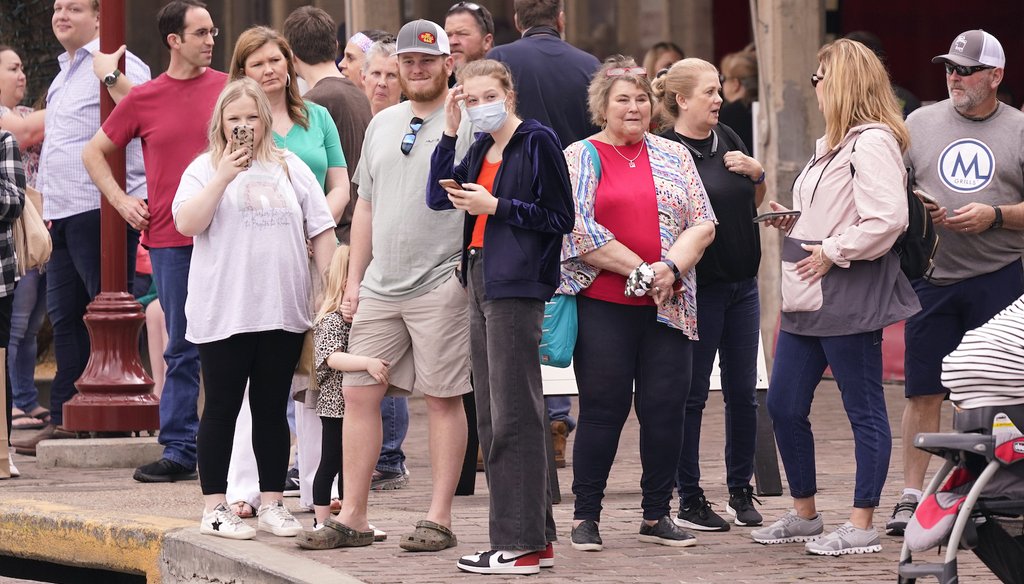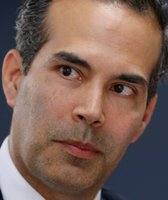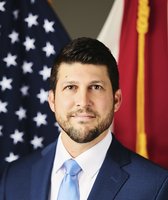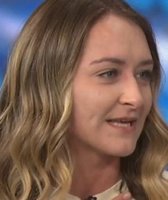Stand up for the facts!
Our only agenda is to publish the truth so you can be an informed participant in democracy.
We need your help.
I would like to contribute

Spectators wait to watch a cattle drive demonstration at the Fort Worth Stockyards Thursday, March 11, 2021, in Fort Worth, Texas. Gov. Greg Abbott allowed the state mandates for COVID-19 safety measures to expire so people can forgo masks. (AP)
Calculating herd immunity is more than 'simple math'
Gov. Greg Abbott is optimistic about the state of the coronavirus pandemic in Texas, where the trend line of daily new cases has dropped from wintertime highs to springtime lows not seen since September.
The reason behind his optimism, he told Fox News host Chris Wallace during an April 11 interview, is based on "simple math."
"We absolutely aren't declaring victory at this time. We remain very vigilant and guarded and proactive in our response, but there's simple math behind the reason why we continue to have success," Abbott said.
He went on: "When you add all the number of vaccinations that are taking place, as well as all of the acquired immunity from Texans who have been exposed and recovered from COVID-19, it means, very simply, it’s a whole lot more difficult for COVID to be spreading to other people in the state of Texas."
Abbott’s calculation begged Wallace’s next question: "Do you think you have herd immunity in Texas now?"
"It looks like it could be very close to herd immunity," Abbott replied.
As of April 12, about 5.8 million people had been fully vaccinated in Texas, or about 20% of the state population, according to state data. Additionally, the state has recorded about 2.8 million positive cases or probable cases, identified through antigen testing, since the beginning of the pandemic. Subtract from that total the 50,000 cases that have resulted in deaths. The rest, about 2.75 million Texans, have recovered from infection and are presumed to have some level of natural immunity to future infection.
Does the combined number of vaccinated people plus those with natural immunity — a total of 8.55 million people in a population of 29 million — bring Texas "very close to herd immunity"? We found that there are several other factors and caveats that Abbott’s equation omits. Calculating a population’s immunity level and its herd immunity threshold is more than a matter of simple math.
What is the herd immunity threshold?
In his interview with Wallace, Abbott said that even though he thinks Texas is "very close" to reaching herd immunity, he doesn’t know what the herd immunity threshold is. And epidemiologists agree that a population’s threshold is somewhat of a moving target.
Simply defined, herd immunity threshold is the percentage of a population that must be immunized from a disease, be it through infections or vaccinations, for the spread to abate. The more infectious a contagion, the higher its threshold.
Measles, for instance, is a highly infectious disease that is at least three times as contagious as COVID-19. Measles requires a herd immunity threshold level of around 94%, meaning that 94% of a population will need to be immune to measles before its transmission rate declines. This has been achieved through the widespread use of vaccinations.
COVID-19's herd immunity threshold level is not yet known. Most estimates have placed the threshold at 60%-70%, according to the peer-reviewed science journal Nature. Dr. Anthony Fauci, the White House chief medical advisor and director of the National Institute for Allergy and Infectious Diseases, has cited a range of threshold levels that has changed as more has been learned about the virus.
Early on in the pandemic Fauci said that threshold was around 60% to 70%. In December, Fauci cited higher figures, saying "I would think that you would need somewhere between 70, 75, maybe 80%," during a CNBC interview.
Dr. James McDeavitt, dean of clinical affairs at Baylor College of Medicine, shares Abbott’s optimism about Texas making progress toward herd immunity, but he says that we won’t know we’ve reached herd immunity until well after we’ve achieved it.
"There are a lot of variables for what actually constitutes herd immunity threshold, and the reality is I don’t think we’ll know when we achieve it until we’re looking backwards," McDeavitt said.
If vaccination rates continue at today’s pace, eventually Texas will see the rate of new daily cases drop to very low levels. After those levels remain low for three to four weeks, he says, scientists could safely say that we’ve surpassed the herd immunity threshold.
"When we see that occur, we can look back and say we achieved herd immunity," McDeavitt said. "But I don't think anybody can do a calculation and predict when that's going to happen."
Abbott’s ‘simple math’
Abbott mentioned two factors that contribute to a population’s immunity — the number of fully vaccinated people and the known number of people who have recovered from COVID-19. These two categories total 8.55 million people, or about 30% of the state population.
An Abbott spokesperson later clarified that the governor also was including the "true number of recoveries," or the category of people who contracted COVID-19 but were never tested and thus never included in the state’s case count. His spokesperson pointed to the U.S. Centers for Disease Control and Prevention’s estimation that only 1 in 4.6 actual infections have been reported.
The CDC says that official case numbers "likely represent only a fraction of the true number of cases that have occurred in the population," and there’s a variety of reasons why cases may go undetected, including asymptomatic people who were never aware of their infection, and people who suffered symptoms but never sought health care.
According to Abbott’s spokesperson, applying the CDC’s estimation to Texas would mean that another 10 million cases have gone undetected. Adding in that total would bring Texas’ immunity rate up to around 60%, the spokesperson said.
Officials at the Texas Department of State Health Services did not respond to questions asking for an evaluation of Abbott's calculation.
But applying the CDC’s estimate to Texas is just one of several ways to calculate the unknown number of cases in the population, said Josh Michaud, associate director for global health policy at the Kaiser Family Foundation.
"There is a significant portion of the population that has acquired immunity — they've been infected and they've recovered," he said. "How big of a slice of the population is that? That's up for debate."
The University of Texas Coronavirus Antibody Response Survey takes a different approach to estimating that total. It estimates that the seroprevalence rate in Texas, or the percent of people with COVID-19 antibodies in their bloodstream, is around 26%. Under those estimates, around 5.1 million cases in Texas could have gone unreported. That would peg Texas’ immunity rate at around 45%.
"It’s a guess, because we just don't have all the information at our fingertips," said Michaud. "But triangulating from different surveys, from different models, you can kind of get a sense of what we're talking about here."
There are other factors that Abbott’s "simple math" omits. First, there’s an overlap in the number of people who have had a prior infection and received a vaccine, yet there’s no way to tell how many people fall into both categories, experts said.
Second, none of the available vaccines are 100% effective. The Pfizer vaccine is reportedly 95% effective; the Moderna vaccine is 86% effective; and the single-dose Johnson & Johnson vaccine, now suspended, is 72% effective.
Furthermore, there’s also uncertainty about whether fully vaccinated people could transmit the virus to others.
"We hope that within the next five or so months we’ll be able to answer the very important question about whether vaccinated people get infected asymptomatically, and if they do, do they transmit the infection to others," Fauci said in a March 26 White House press briefing.
These factors — the overlap between vaccinated and recovered people and the unlucky people unprotected by the vaccine — would subtract from Abbott's estimated level of immunity, Michaud said.
Health officials also urge anyone who’s ever had a prior infection to get vaccinated because acquiring antibodies through natural infection does not offer as much protection against the virus or its variants. It’s also unclear how long natural immunity lasts. Take for example Brazil President Jair Bolsonaro, a coronavirus skeptic who has famously been diagnosed with COVID-19 three times.
"The governor said that we are ‘close’ to herd immunity. Depending on your definition of ‘close,’ that may be the case," Michaud said.
"We are getting closer to herd immunity, however you define it, because we're vaccinating more people over time. But are we there now? The answer is probably no. But when we will get there and what level do we need to get there are still open questions that people are debating," he said.
Our ruling
Abbott said that Texas "could be very close to herd immunity" during an interview on Fox News. He said he based this assessment on "simple math," which is the number of people who have been fully vaccinated plus those who have natural immunity — those who have been infected and recovered and an estimated number of those who were infected and were not tested.
About 5.8 million people, or 20% of the state population, has been fully vaccinated as of April 12. The total number of people who have recovered from COVID-19 is not known, although various estimates show that it ranges from 25%-40% of the state population.
Adding those totals together would mean that the state's immunity level ranges from 45-60%, while the herd immunity threshold is understood to range between 60-80%.
However, other factors would subtract from the state's immunity level, like the fraction of people who receive a vaccine but aren’t protected, or the overlap of people who recovered from prior infection and received a vaccine. But there are no estimations for how many people fall into either of these categories, experts said.
Furthermore, health officials urge everyone to get vaccinated — whether or not they've recovered from a past infection — because immunity from vaccines is known to be more durable than natural immunity.
We rate this claim False.
Our Sources
Fox News Sunday, Abbott: Immigration crisis will 'continue to get worse' under Biden policies, April 11, 2021
Texas Health and Human Services, Texas COVID-19 dashboard
Texas Health and Human Services, COVID-19 vaccinations dashboard
PolitiFact.com, Examining how science determines COVID-19's 'herd immunity threshold', Jan. 5, 2021
CNBC, CNBC Transcript: Dr. Anthony Fauci Speaks with CNBC’s Meg Tirrell Live During the CNBC Healthy Returns Livestream Today, Dec. 16, 2020
U.S. Centers for Disease Control and Prevention, Estimated Disease Burden of COVID-19, Jan. 19, 2021
UT Health, Texas CARES Dashboard
Interview with Josh Michaud, Associate Director of Global Health Policy at the Kaiser Family Foundation, April 13, 2021
Interview with James McDeavitt, Senior Vice President and Dean of Clinical Affairs at Baylor College of Medicine, April 13, 2021
Yale Medicine, Comparing the COVID-19 Vaccines: How Are They Different? April 13, 2021
White House, Press Briefing by White House COVID-19 Response Team and Public Health Officials, March 26, 2021
Health World, Brazilian President tests COVID-19 positive for third time, July 23, 2021
Browse the Truth-O-Meter
More by Brandon Mulder
Calculating herd immunity is more than 'simple math'
Support independent fact-checking.
Become a member!
In a world of wild talk and fake news, help us stand up for the facts.
















































